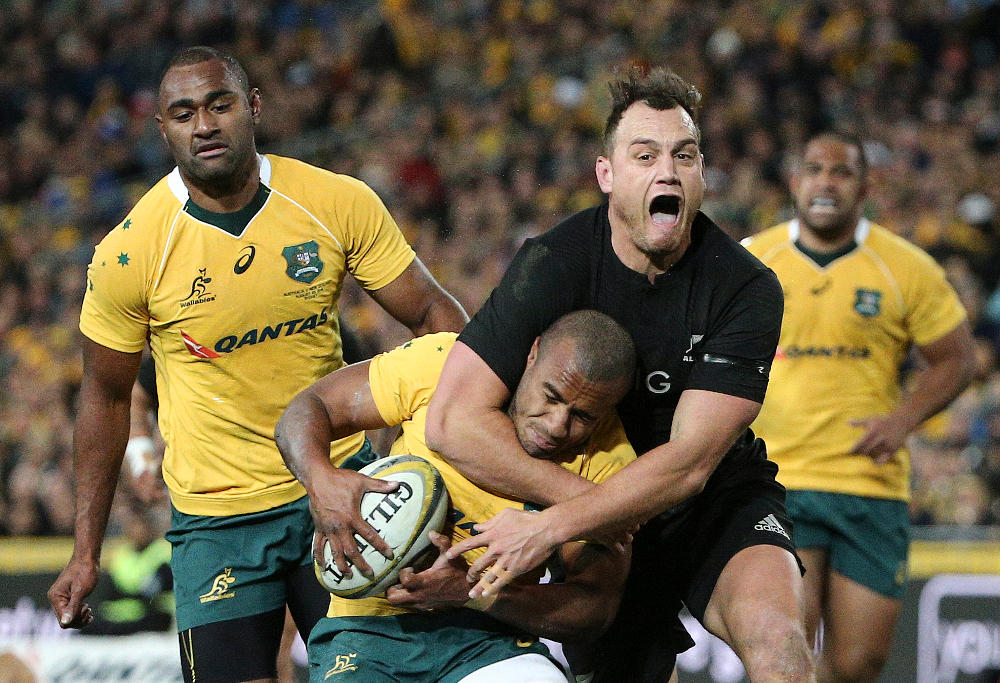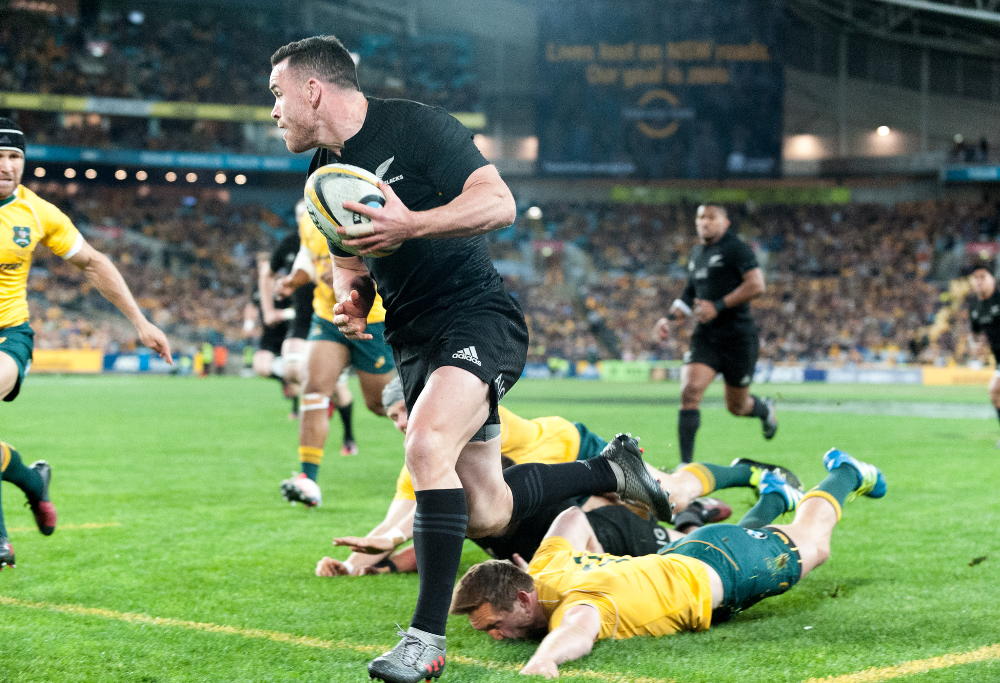Hansen's done Joey Manu no favours comparing him to SBW. He'll be more like RTS - and Foz is the reason why
I don’t really get the comparisons between Joey Manu and Sonny Bill Williams. I realise they have the Roosters in common, along with a…

In a previous thread on an article written by Steiner about the Wallabies 1-3-3-1 attacking structure I had a bit of a rant about my admiration for the 2-4-2 attacking structure used by the All Blacks and their provincial teams.
Not satisfied with the height of my soapbox, I have decided to post an article of my own praising and advocating this true and tried method.
As most of you will now, the 2-4-2 simply means that the forwards set up across the field in a 2-4-2 formation. This consists of a pod of the two props and locks in the middle of the field, with two pods consisting of the hooker and blindside flanker/eighth man and the open side flanker and blindside flanker/eighth man in each of the 15 metre tram tracks. It usually takes between one and three phases to set this structure up from a set piece or even general play.
Once the structure is set up the backs set up around this structure. The left wing sticks with the hooker and blindside flanker/eighth man pod on the left-hand side of the field and the open right winge sticks with the open side flanker and blindside flanker/eighth man pod on the right-hand side of the field.
The scrum half roams around between these three pods to provide service. The fly half and inside centre usually pair up on one side of the field between the middle pod of four forwards and the outside pod of two forwards/winger and the outside centre and fullback usually pair up on the other side.
Automatically the defence is forced to stretch from one side of the field to the other, leaving much bigger spaces in between the defenders. It also allows for ball security at the breakdown because there are always at least two forwards present to secure the ball – but I will not discount the incredible skillset of the All Blacks at the breakdown.
Most importantly, the forwards do not have to do as much work because the ball gets moved towards them when the opportunity arises instead of them having to run after the ball.

(AAP Image/SNPA, David Rowland)
The space also allows the forwards more room in which to manoeuvre and not having to have them run into brick walls all the time to get front foot to ball. It also means the forwards can step diagonally into the contact zone between two defenders, which is much less physically taxing and easier to breach the gain line than running into a brick wall of defenders.
To help the forwards reduce the workload even more, the inside centre and blindside winger are selected and played as extra loose forwards. Both are used as crash runners, and the inside centre does get through a good share of breakdown work.
This simple and energy efficient structure allows the forwards to keep gas in the tank for when it matters – for example, running hard and fast when the attacking iron is hot or scrambling on cover defence. It is also noticeable that teams that use this structure usually excel in the latter part of the game because their forwards have more gas left in the tank.
A side note on the All Blacks forwards: the All Blacks have placed a massive emphasis on selecting athletes and not just brutes in the forwards. While they select big men, they are big men with running in their legs. This is because their forwards very seldom have to run full frontal into a defensive line – they almost always have the space to run diagonally into the space between defenders and to try for the offload or just to simply breach the gain line to make the defensive line backpaddle.
Where the All Blacks have excelled, though – and it is very simple – is in working hard on the individual skills of their forwards. This is rugby coaching 101, and every kid getting coached in every country will (I hope) be run through the same drills – passing off both hands, catching, jumping, tackling. These are the very basics of the game.
Another side note on the All Blacks backs: the 2-4-2 structure allows them carte blanche in attack and to play what unfolds in front of them. Their creativity and intuition are encouraged.

(AP Photo/Rob Griffith)
While their attack looks off the cuff and unpredictable, it is made possible by the 2-4-2 structure that provides a very simple and effective basis for it. Because the defence is stretched with bigger gaps in between and because they can roam between the pods, they can quickly identify any gaps on the defensive line and act on it.
The 13 and 15 are always ‘vision players’, if not players with playmaking ability, and they make the calls from the outside or run to where they see the space developing. This is smart and simple. As an outside centre and especially as a fullback you are in a much better position to see play unfold than, say, a ten or 12 who are in the thick of it.
The options for where, when and how to attack in this system are boundless and a decision must be made in a split second. The All Blacks are constantly tweaking and evolving this ‘off the cuff’ attack, most importantly by using simple, easy-to-understand plays. One very simple method they have been using is to very quickly flood one side between the middle four-man forward pod and the wide two-man forward pod with their backs and rely on quick, simple hands to get the overlap.
It also helps when your coach allows you to constantly train space identification, general skills and space creation and supports play in real match scenarios at training.
The interplay between the four-man forward pod in the middle of the field has been taken to new heights by the All Blacks but, again, it is simple stuff – a pass behind the forward next to you to a back, a dummy run, quick hands et cetera.
The forwards in the side pods also stick to the simple plays – run an angled run, quick hands, pass behind the back et cetera – and always endeavour to make the offload, which they can afford to attempt because the defenders are spread so far apart that two-man tackles that attempt to rip the ball league-style are near impossible and very risky for want of a quick pass into the void left by the two gang-tackling forwards.
And it is not just the forwards who benefit physically from this structure; the backs do too. The wingers stick on their wings without much running – except when the attacking iron is hot and on scramble defence – with the occasional crash ball run by the left winger.

(Tim Anger).
The flyhalf, inside centre, outside centre and fullback just transition the ball between the pods and attack at their leisure when the space develops – they pretty much stick to a set channel within the field. Again, this is why they look so dynamic in the latter part of the match compared to opposition backs.
A thought is spared for the scrum half in this structure. This guy needs to be super fit and gets through a lot of work. But, again, note how many times a forward or another back clears the ruck in an attempt to lighten the workload on the scrum half. Again, I will not take away from All Blacks backs’ supreme conditioning.
Instead of changing the structure they use or tweaking it too dramatically, the All Blacks brains trust have very smartly and very simply decided to turbocharge their structure by working overtime on fitness and skills. They probably realise that this is very simple, easy to grasp, requires less thinking and concentration and is a proven structure is not worth changing.
Most important is the ability to very quickly transition to defence with this attacking structure. In the rare event that the ball is turned over, all players are already spread across the field, and it takes minimal lateral movement to form one uniform line across the field.
Because the backs hang slightly behind the three forward pods in attack, the ten and 15 are already halfway there if a kick is made in behind from the turnover. Pressure relieving/passing option support always comes from the 14, which is almost always selected as an extra fullback, or at least a player who can also kick.
New Zealand Rugby Union has very smartly decided to make this structure uniform from grassroots to international level, which means every player in New Zealand instinctively knows this very basic structure. Every one of their teams develops their own attacking variations to it, but when you know the basic structure they are not hard to pick up at all. Some of their more advanced teams even venture out to a slightly different attacking structure from time to time, but they always master the 2-4-2 structure first.
I have not commented on the All Blacks’ general defence and counter-attack in this brief summary because my keyboard is taking a pounding and no doubt I have forgotten to mention some of the finer details of this structure. It’s a structure that is near impossible to unlock with very few, if any, weaknesses and with an attack that is almost impossible to analyse because it is largely impromptu.